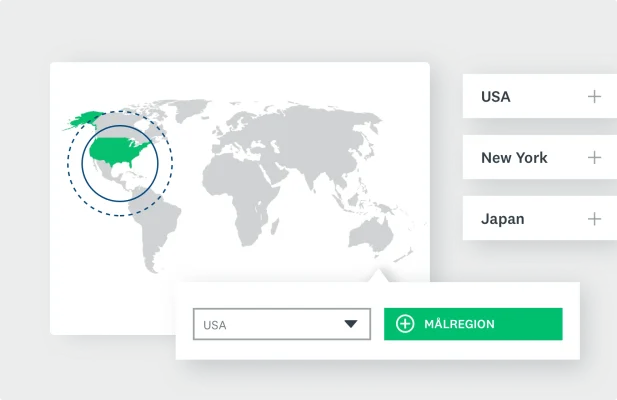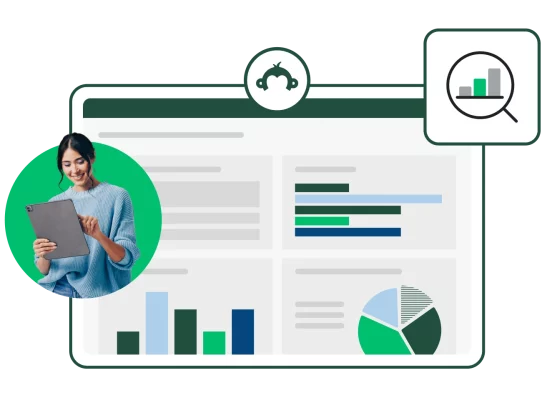Fem typer markedssegmentering, og hvordan de bruges (med eksempler)

- Markedssegmentering er en fremgangsmåde, der bruges til at kategorisere et bredt forbrugermarked til mindre, forskellige grupper baseret på fælles karakteristika.
- Markedssegmentering er afgørende, da det giver virksomheder mulighed for at fokusere på specifikke grupper mere effektivt, hvilket fører til bedre kundetilfredshed og bedre forretningsresultater.
- De fem typer markedssegmentering er demografisk, psykografisk, adfærdsmæssig, geografisk og firmografisk segmentering.
Tænk på dine kunder som en levende mosaik, der hver især er unik, men som alligevel har ligheder, der går som en rød tråd gennem dem. Markedssegmentering er kunsten at genkende disse mønstre, gruppere kunderne ud fra deres fælles træk og udarbejde strategier, der har betydning for deres samlede behov og ønsker.
Virksomheder kan målrette reklamekampagner til disse segmenter mere effektivt, når der er etableret grupper ved hjælp af markedssegmentering. Hvert segment kan have visse præferencer, der adskiller dem fra hinanden. Når virksomheder fokuserer på, hvad hver gruppe gerne vil have, kan de forbedre engagementet, øge interaktionen og fremme salget.
Hvad er markedssegmentering?
Markedssegmentering er en proces, hvor en bred befolkning deles op i undergrupper ud fra visse fælles faktorer. Disse grupper kan have fælles demografi (alder, køn osv.), geografisk placering, holdninger, adfærd eller en kombination af lignende karakteristika.
Når der skabes mindre grupper baseret på fælles faktorer, kan vi bedre sætte fokus på vores målgruppe.
Ved du, hvad der kendetegner din målgruppe?
Få svaret på få minutter med SurveyMonkeys forbrugersegmentering.
Hvorfor bruge markedssegmentering?
Markedssegmentering gør det muligt for en virksomhed at udvikle detaljerede profiler af de enkelte markedssegmenter. Når segmenterne er klart definerede, kan markedsføringsmedarbejdere udvikle strategier til de segmenter, som med højst sandsynlighed vil købe virksomhedens produkter og tjenesteydelser.
For at nå dette mål udfører markedsføringsmedarbejdere en tretrinsproces, der præciserer hvem de mennesker er, og hvorfor de køber produkter.
- Segment: Markedsføringsmedarbejdere opdeler markedet i kategorier baseret på fælles træk.
- Mål: De vælger det marked eller den målgruppe, som er mest tilbøjelig til at købe deres produkter.
- Position: Markedsføringsmedarbejdere undersøger, hvilke kombinationer af produkter, priser, kampagner og lokationer, der vil få kunderne til at købe deres produkter.
Når markedsføringsmedarbejderne har isoleret deres målgruppe, skal de definere, hvordan deres produkt er anderledes. Er det bedre, hurtigere, billigere eller mere avanceret end konkurrerende produkter? For at besvare disse spørgsmål skal markedsføringsmedarbejdere kende deres målgruppes problemer, og hvordan de kreativt kan løse disse problemer.
Virksomheder skaber en konkurrencemæssig fordel for sig selv gennem produktdifferentiering, så deres produkter og tjenester markerer sig som løsninger på købernes problemer.
Når markedsføringsmedarbejdere identificerer en målgruppe, isolerer deres problemer og skaber et produkt, der løser disse problemer, har medarbejderne større sandsynlighed for at få succes i forhold til deres konkurrenter.
Eksempler på markedssegmentering
Markedssegmentering er det første skridt til vellykket produktmarkedsføring. Uanset om virksomheder henvender sig til forbrugere eller virksomheder, kan markedssegmentering hjælpe til en større forståelse af kundernes problemer og bidrage til en løsning.
Ikke alle virksomheder segmenterer deres kunder på samme måde. Der findes flere forskellige tilgange, som virksomheder kan bruge.
Her er tre ordinære eksempler på markedssegmentering.
Ingen segmentering
Virksomheder bruger massemarkedsføring til at sælge deres produkter til alle ved hjælp af en udifferentieret strategi. For eksempel vil virksomheder med varer som salt eller generiske varer med mange substitutter måske ikke bruge mange kræfter på at segmentere deres marked.
Begrænsede segmenter
Virksomheder kan bruge en eller flere snævert definerede målgrupper til at skabe et meget fokuseret nicheområde til specialiserede produkter. Det kan for eksempel være eksklusivt modetøj, håndlavet kunst eller specialfremstillede maskindele.
Tusindvis af segmenter
Også kaldet hypersegmentering – markedsføringsmedarbejdere kan skræddersy en kundefokuseret markedsføringstilgang for at udvikle en langvarig relation til den enkelte kunde. Det kan for eksempel gælde udbydere af personlige serviceydelser såsom frisører og online forhandlere såsom Amazon, der tilbyder kunden personligt tilpassede anbefalinger baseret på købshistorik.
Fem typer markedssegmentering
Din virksomhed bør forstå de fem forskellige typer markedssegmentering, uanset om du vil skabe en håndfuld segmenter eller tusindvis.
Lad os se nærmere på demografisk, psykografisk, adfærdsmæssig, geografisk og firmografisk segmentering, hvad de hver især indebærer, og hvordan hver type bruges.
1. Demografisk segmentering
Demografisk segmentering forudsætter, at mennesker med fælles karakteristika vil have lignende livsstilsmønstre, smag og interesser, som vil påvirke deres købsvaner. Demografi kombineres ofte med andre segmenteringsmetoder for at udvikle målgrupper med størst sandsynlighed for at købe deres produkter.
Demografi omfatter faktorer såsom alder, køn, beskæftigelse, indkomst og uddannelse.
Sådan bruger du demografisk segmentering
Fordelen ved demografisk segmentering er, at dataene til den er nemme at indsamle. Offentlige kilder, herunder Bureau of Labor Standards (i USA), leverer data om husholdninger, indkomst, uddannelse og sundhed til markedsføringsstrategi og forretningsmål.
Når markedsføringsmedarbejderne har brugt demografi til markedssegmentering, kan de bruge de samme oplysninger til kundesegmentering. Ved hjælp af demografi og adfærd, kan de identificere:
- hvor stor markedsmuligheden er for mit produkt
- hvordan mit brand er i forhold til konkurrenterne
- hvilke demografiske grupper er mest tilbøjelige til at købe mit produkt eller min tjeneste
- hvilke kampagner vil give bedst genklang hos min målgruppe.
Når demografisk segmentering bliver kombineret med adfærdstræk og andre variabler giver det værdifulde indsigter i, hvilke specifikke kunder i markedet, der vil købe produktet, samt en bedre forståelse af, hvordan man kan nå dem med de rette markedsføringsbudskaber.
2. Psykografisk segmentering
Psykografisk segmentering inddeler mennesker i grupper, baseret på deres personlighed, livsstil, sociale status, aktiviteter, interesser, meninger og holdninger. Psykografik er et glimrende supplement til demografi, fordi disse data identificerer motiverne bag folks valg.
Har du tjekket din målgruppedemografi for nyligt?
Forandring sker hurtigt. Bliv endnu mere fokuseret med SurveyMonkeys forbrugersegmentering.
Sådan bruger du psykografisk segmentering
Psykografisk segmentering er en effektiv måde til at finde ud af dine kunders problemer, adfærd og holdninger på.
Virksomheder bruger psykografisk segmentering til at finde ud af:
- hvordan forbrugerne opfatter deres produkter og tjenester
- hvad forbrugerne rent faktisk gerne vil have og hvorfor
- manglerne eller smertepunkterne ved deres nuværende produkter eller tjenester
- mulighederne for fremtidigt engagement
- hvordan de bedre kan kommunikere med deres målgruppe.
3. Adfærdsmæssig segmentering
Adfærdsmæssig segmentering beskriver specifikke trin i den ideelle kundes købsproces. Denne form for segmentering omfatter, hvad ideelle kunder vil have, hvorfor de vil have det, de ønskede fordele, samt hvordan de får opfyldt deres behov.
Sådan bruger du adfærdsmæssig segmentering
Virksomheder kan bruge adfærdsmæssig segmentering til at analysere B2C- og B2B-markedssegmenter. Når virksomheder forstår, hvorfor folk køber, kan de bedre fokusere deres markedsføringsbudskaber. Adfærd kan omfatte:
- Købsårsag: Går køberne efter den bedste pris, fantastiske anmeldelser, sikkerhedsovervejelser eller andre kriterier?
- Anledning eller begivenhed: Køber forbrugerne til en højtid eller en årsdag? Prøver B2B-indkøbere at bruge deres budget inden årets udgang?
- Produktfordele: Overvejer køberen at købe den nyeste teknologi, det sikreste produkt eller at være den første til at købe det nyeste produkt?
- Kunderejsens fase: Vil køberen have information til et fremtidigt køb? Eller ønsker køberen at prøve brandet for første gang?
- Engagementsniveau: Er køberen en inkarneret fan, der er på udkig efter det nyeste produkt?
Når markedsføringsmedarbejderne ved, hvorfor forbrugere eller virksomheder køber deres produkter, kan de gøre det til en del af deres segmenteringsstrategi at adressere disse typer adfærd.
4. Geografisk segmentering
Geografisk segmentering giver markedsføringsmedarbejderne mulighed for at gruppere folk ud fra, hvor de bor, arbejder eller rejser.
Lokation har en betydelig indflydelse på købsvanerne, hvilket markedsføringsmedarbejdere kan bruge til at udvikle deres markedsføringsbudskaber. Markedsføringsmedarbejdere bruger forskellige geografiske segmenteringsvariabler, som omfatter land, region, detstat, provins, by, klimazone eller postnummer.
Kultur og befolkningstæthed (by eller land) er også vigtige variabler at inddrage i markedsundersøgelsen. Disse lokationsvariabler vil påvirke, hvilke problemer folk har i den pågældende region, og hvordan markedsføringsmedarbejdere kan løse dem.

Sådan bruger du geografisk segmentering
Hvor en person bor, kan påvirke alt fra personens madvalg til den bil, personen kører i. Virksomheder kan bruge geografisk segmentering til at finde frem til de produkter, der er bedst at sælge til deres kunder.
Et eksempel på geografisk segmentering er markedsføring af planter baseret på klimazone. Pelargonier er bedst til varme og solrige steder og blågran til steder med en hård vinter. Kendskab til det geografiske områdes detaljer hjælper markedsføringsmedarbejdere med at identificere, hvilke planter, jord og haveudstyr der sælger bedst i hvert klima.
Alternativt kan et tøjfirma anbefale frakker til en person, der bor i et koldere miljø. Hvis du tilpasser de produkter, du reklamerer for til en kunde, baseret på kundens lokation, kan det radikalt ændre, i hvor høj grad kunden overvejer at købe.
Relateret læsning: Den komplette guide til spørgeundersøgelser til segmentering
5. Firmografisk segmentering
Firmografisk segmentering er forB2B-markedsføring, hvad demografi er for B2C-markedsføring. Firmografi afdækker målgruppens kendetegn inkl. oplysninger om den pågældende virksomheds branche, antal medarbejdere, juridisk status, virksomhedsstørrelse, økonomisk situation og andre relaterede variabler.
Millioner af mennesker flytter hver år. Har dine målgruppers geografiske profiler ændret sig? Få svaret på få timer med SurveyMonkeys forbrugersegmentering.
Sådan bruger du firmografisk segmentering
Firmografi leverer oplysninger til markedsføringsmedarbejdere, der ønsker at sætte sig ind i virksomheders styrker og levedygtighed inden for deres målgruppe. De fokuserer på deres økonomiske resultater og væksttendenser for at se, om markedssegmentet vokser eller har tilbagegang.
Eksempler på firmografisk data inkluderer:
- Brancheklassificering: NAICS-kode (North American Industry Classification System)
- Ejerskab og juridisk status: Ejerforhold, herunder enkeltmandsvirksomheder, virksomheder med begrænset ansvar (v.m.b.a.), partnerskaber med begrænset ansvar, private virksomheder og offentligt ejede aktieselskaber.
- Aktive år: Virksomhedens aktive år kan være en indikator om økonomisk styrke og brancheerfaring.
- Antal medarbejdere Antallet af medarbejdere viser, hvor stor virksomheden er.
- Placering Virksomhedens geografiske placering og adresser på kontorer, fabrikker eller butikker.
- Kunder og produkter Hvilke produkter virksomheden fremstiller eller sælger, og hvem deres målgruppe er.
- Markedsstørrelse Hvor stort deres marked er, og hvem der er deres konkurrenter.
Fordele ved markedssegmentering

Markedssegmentering er grundlaget for succesfulde produktkoncepter, lanceringer, markedsføringsbudskaber, reklamer og andre vigtige markedsføringsaktiviteter.
Virksomheder investerer vigtige ressourcer med det formål at finde ud af deres ideelle kundes problemer, så de kan løse disse udfordringer med værdifulde produkter og tjenester. Hvad får virksomhederne ud af at investere tid og kræfter i markedssegmentering?
Bedre reklamekampagner
Virksomhederne bruger milliarder af dollars på marketing og reklame, når de ved præcis, hvem deres målgruppe er, og hvad målgruppen ønsker. Markedsføringsmedarbejdere indsamler store mængder data for at sikre, at deres budskaber appellerer til de rigtige kunder, på det rigtige tidspunkt og med de rigtige produkter.
Spørgeundersøgelser er en god måde at teste markedsføringsbudskaber på for at se, om de appellerer til målgruppen. De begynder med at udvikle en hypotese om, hvordan de tror deres respondenter vil reagere. Spørgeundersøgelsens resultater hjælper dem med at udvikle bedre budskaber og mere vellykkede kampagner.
Udvikling af målrettede produkter
Virksomhederne har gode idéer til nye produkter, men de skal undersøge om idéerne løser et problem for deres målgruppe. Uden markedssegmentering kan virksomhederne spilde tid og kræfter på et produkt, der måske lyder godt i teorien, men som ikke sælger godt.
Spørgeundersøgelserne tager pulsen på en målgruppe. I løbet af få timer har virksomhederne svaret på, om:
- de løser et problem for deres målgruppe
- en eller flere af deres ideer er en klar vinder
- deres produktkoncept har de rigtige funktioner, den rigtige emballage og det rigtige logo
- køberne vil købe produktet, og til hvilken pris.
At få de rigtige svar fra en veldefineret målgruppe hjælper virksomhederne med at fokusere på vellykkede produkter, som kunderne gerne vil købe.
SurveyMonkeys løsning til test af koncept vil fortælle dig, om den nye produktidé er en vinder. Få et produktperformance scorekort, og sammenlign med benchmarks i branchen.
Identificer nye tendenser og muligheder
Tendenser skifter hurtigt. Sociale medier kan give indsigt i nye typer kundeadfærd, men markedsføringsmedarbejdere ved ikke, om de er levedygtige muligheder, medmindre adfærden bliver målt.
Forståelse af en målgruppes adfærd er kernen i markedssegmentering. Når nye tendenser dukker op, er det op til markedsføringsmedarbejdere at undersøge, hvilke der er nye muligheder, og hvilke der vil forsvinde fra den ene dag til den anden.
Det er markedsføringsmedarbejdernes opgave at identificere kommende kundeproblemer, definere nye markedsføringsbudskaber og teste nye produktkoncepter. For at kunne identificere nye muligheder skal markedsføringsmedarbejderne løbende teste målgrupperne for at få nye indsigter og undersøge, om kunderne stadig kan lide de eksisterende produkter.
Giv input til virksomhedsdriften
Markedssegmentering indeholder et robust datasæt med kundedata, som andre afdelinger kan bruge til at hjælpe virksomheden med at få succes. I B2B-virksomheder er markedsførings- og salgsafdelingerne ofte tæt forbundne, og salget afhænger af markedsføring for at generere kvalificerede kundeemner, der giver større omsætning.
Afdelingen, der fastsætter priserne på produkterne, har også behov for markeds- og konkurrentdata for at kunne prissætte produkterne korrekt og sikre konkurrencedygtigheden. Ingen produktionsafdeling ønsker at skulle arbejde overtid på grund af et pludseligt opstået behov for 100.000 dippedutter forårsaget af øget efterspørgsel, og derfor er delingen af købertendens og -efterspørgsel med til at holde produktionen på sporet
Markedssegmenteringsdata er ikke kun for markedsføringsmedarbejderne. Du skal dele dataene, så hele virksomheden kan betjene kunderne bedst muligt.
Skab tillid til brandet
Virksomhederne ønsker at gøre mere end blot at sælge produkter til deres målgruppe. De ønsker at etablere en relation til deres kunder, så de fortsætter med at købe virksomhedens produkter. Når kunderne kender, holder af og fortsat køber en virksomheds produkter, er der skabt tillid til brandet.
Markedssegmentering identificerer, hvilket publikum der med størst sandsynlighed vil købe – ikke bare én gang, men også i fremtiden. Ved at skabe en brandidentitet, som kunderne sætter pris på, kan virksomhederne begynde at styrke brandkendskab og opbygge en relation til deres målgruppe baseret på tillid. Ved at leve op til denne tillid og udvikle nye produkter, værdifuldt indhold samt aktuelle oplysninger, kan de skabe en kundeoplevelse, der får forbrugere og B2B-kunder til at komme tilbage for at købe mere i fremtiden.
Segmentering af målgrupper hjælper markedsføringsmedarbejdere med at få en forståelse af den ideelle kundes problemer og adfærd, hvilket skaber løsninger, der opbygger en langsigtet brandtillid, som er til gavn for begge parter.
Hvilken relation har du til din målgruppe?
Få at vide, hvad der skal til for at opbygge tillid med SurveyMonkeys brandsporing.
Segmenter dine data med SurveyMonkey
Når virksomheder forstår markedssegmenteringen, kan de skabe mere engagerende, skræddersyet indhold, som alle kunder vil holde af. Segmentering af din målgruppe er afgørende for at kunne levere effektivt markedsføringsmateriale og øge engagementet hos dine kunder.
Find ud af mere om segmentering af dine data med SurveyMonkey, oprettelse af detaljerede kundegrupper, som gør meget effektiv virksomhedskommunikation mulig. Tilmeld dig i dag for at komme i gang med kundesegmentering.
Kom godt i gang med din markedsanalyse
Globalt spørgeundersøgelsespanel
Indsaml markedsundersøgelsesdata ved at sende din spørgeundersøgelse til en repræsentativ stikprøve
Ekspertløsninger
Test kreative koncepter og produktkoncepter via en automatiseret tilgang til analyse og rapportering.
